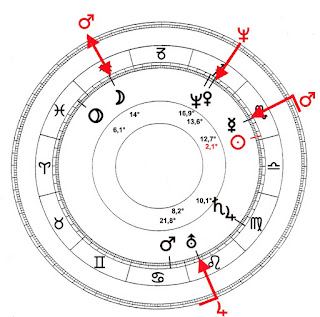For an answer then look to the sky. However, the astrologers of antiquity would not have been looking for Neptune, because it was discovered only in 1846. In the view of their time, the affairs of Pisces were indicated by Jupiter to the then Lord of Sagittarius and Pisces, so they would have been looking for this one and then they would still have had to distinguish between the Pisces meaning of Jupiter and its meaning as the ruler of the sign Sagittarius.
We, on the other hand, have to look at Neptune in point of the sea, but because of its great distance, it is known that it cannot be seen with the naked eye. And until recently we were using the celestial tables, those "tables of the night", which are ephemeris (from gr. ephemeris = diary). From them we took the daily star stands. Until the computer age, ephemeris were printed, today they are available for free on the Internet for a period of 7000 years. The respective star statuses, read and recorded, lead us to the question of their evaluation and thus to the significance of the constellations.
The angles of 0°, 90°, and 180° are called conjunction, opposition, and square; they are
the main constellations that indicate that in the world, especially in suitable places, different world components are "swinging" into a common event. It should be noted that in astrology, in addition to these four main constellations, all possible angular positions of the stars are observed and interpreted. [2]
It is experience that the ideal case of a conjunction of 0° or a square of 90°, or an opposition of 180°, is often not needed for an effect to become visible: even the run-up of a still "weak square" at an angle of say 85 ° often already acts as a constellation. This area of activity is called "orbis" and astrologers limit it to more or less 7 °, the Sun and the Moon also more.
If all events were indicated solely by the current daily constellations, Venus and Neptune would be connected in one of these three main constellations in the sky above "Salamis", without ifs and buts. If we look at the daily horoscope with the planets known at that time, there is no main constellation of Venus with Jupiter to be recognized. At most, that Pisces - ruler Jupiter is in the 'city- sign' of Taurus. But this happens every 12 years for a year and is not enough as an indicator of a historical situation.
29.9.480 BC Naval battle in the Gulf of Salamis, ancient style
29.9.480 B.C. Naval battle in the Gulf of Salamis
todays style
There is no connection of Venus neither with Jupiter nor with Neptune. According to all experience, a clear picture of the sky with a direct connection of the two stars in question corresponds to such a concise state as "city on the water".
But the second oracle had ended with the following words:
" Divine Salamis, you will destroy the children of women,
When the demeter grain is sown or harvested.“[4]
However - the daily constellation does not provide a compelling analogy to what is happening on Earth.
Now let's try the Kingsconjunction. Here the reader will ask what one should imagine under a king conjunction.
In the first chapter I go into this question in detail, so here in the introduction just so much: it is a meeting of Saturn and Jupiter, under circumstances that only occur about once every 800 years. Now if at the moment of the meeting of the two planets a snapshot of the entire solar system, as seen from the Earth, is taken, then one has the Kingsconstellation with the exact zodiac locations where the respective lights and planets, the whole heavenly society, were stored at the moment.
Here is the royal constellation of - 642 BC in the Earth element, as it was authoritative until 149 AD:
and here is the transit of the day of Salamis to the Kingsconjunction, the picture is amazing:
Not only does the Kingsconjunction for the 790 years of her 'reign' over the affairs of the Earth element (Northern Hemisphere) generally show the Venus / Neptune connection, but on the day (in the days) of Salamis, the ongoing current Neptune is added as a transit.
1. 11. - 642
Kingsconjunction in the earth element
Transit 29.9.-480
In the Kingsconjunction of 642 BC, Venus was at 13.6° Sagittarius
162 Years later we find Neptune in the early autumn sky of 480 BC.
in his then current position: it is 12.3° Sagittarius1. 11. - 642
Königskonjunction in the earth-element
Transit 29.9.-480 complete
Now there it is, this ascertainable "something", which, as far as I know, cannot yet be explained with previous physical hypotheses: a current celestial position necessarily enters into exactly one constellation with a celestial body of a "king conjunction" which (in this case) dates back 162 years, which corresponds to a remarkable real event on Earth to the hair. A "coincidence", in the colloquial meaning, is to be excluded if it can be proven that such "coincidences" occur repeatedly.
If that were the case, how would that be possible?To be continued,
Murnau 8. 31. 2024, UTC 20:01.








Keine Kommentare:
Kommentar veröffentlichen